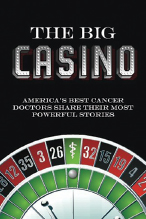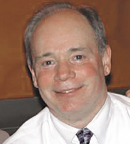
The following essay by A. Collier Smyth, MD, is adapted from The Big Casino: America’s Best Cancer Doctors Share Their Most Powerful Stories, which was coedited by Stan Winokur, MD, and Vincent Coppola and published in May 2014. The book is available on Amazon.com and thebigcasino.org.
I was raised to be an engineer. I grew up in an industrial community, worked summer jobs in a U.S. Steel chemical plant, and was good at science and math. My career choice was straightforward: I went to an engineering university. My first semester freshman year included a mandatory introduction to the program called “On Being an Engineer.” I discovered my purpose every day for the rest of my life would be to make more money for U.S. Steel.
I decided there must be a more satisfying alternative. I’d never thought of becoming a physician, but it seemed to be a vocation dedicated to helping people. When I asked a dorm friend—his father was a general practitioner—what being a physician was like, he didn’t answer but instead offered to take me to meet his dad on a trip home.
As his dad sat at the head of the dining room table with a phone directly at his side ready to reassure the next patient who called, I was converted. I wanted to help patients and their families, one at a time, as often as I could.
Making a Difference in Patients’ Lives
I embarked on a mission. At medical school, I studied and worked with one goal in mind: to prepare myself to make the biggest difference I could in the lives of patients. I stumbled into oncology at Johns Hopkins University School of Medicine, first studying lymphocytes, then tumor immunology, and then working on some of the first bone marrow transplants in the lab and on the adjacent hospital floor. There was no doubt: I wanted to be a hematologist/oncologist in an academic setting.
However, during my internship at Beth Israel Deaconess Medical Center in Boston, I witnessed a physician demonstrate how an oncologist could make a positive difference every minute, in every patient he touched. This was the physician everyone wanted to be. That did it for me. Forget academics; I wanted to take care of patients. After a fellowship at the National Cancer Institute (NCI), I decided to go into solo practice and became the first board-certified oncologist in private practice in New Hampshire.

If the physician keeps the patient as comfortable and active as long as possible—and does not focus on life or death as the sole measure of success—death doesn’t mean failure.— A. Collier Smyth, MD
Tweet this quote
I wanted to care for patients, but this required me to run a business as well. How does one care for patients outside the walls of a teaching institution? The basics of setting up a practice were provided in a 2-day course called “Establishing Yourself in Medical Practice” sponsored by the American Medical Association. When I asked people about starting an oncology practice, the uniform response was, “Go see Stan.”
Rules to Practice By
Stan Winokur, MD, had been 2 years ahead of me at Beth Israel and the NCI. I visited him in Atlanta, where he had a community oncology practice, and followed him around for 2 days. Stan was very thoughtful in everything he did. For example, he instructed me when visiting a patient on morning rounds in the hospital; there were three things you had to do. First, sit down; whether on the bed or in a chair, to talk with the patient. Second, touch the patient: typically by examining the patient but even by putting a reassuring hand around a forearm. Skin has to touch skin. Third, ask if the patient has any questions or needs anything.
Years later, I asked Stan about his sit-down rule. He said he’d learned it from a patient. One day, he’d stopped to see a hospitalized cancer patient. The patient said, “Have a seat, Doc.” Stan replied that he was comfortable standing.
“No, please Doc, have a seat,” the man repeated.
“No really. I’m fine, thank you.”
Then the man said, “You don’t understand, Doc. I’m not asking you to sit down for you, I need you to sit down for me.”
I put that rule into practice with my first hospitalized patient. I remember her name to this day—Mrs. Gryzenski. Seeing her on morning rounds, accompanied by a nurse, I sat on her bed, just below and to the side of one hip. Mrs. Gryzenski was under a sheet and blanket, lying flat in the bed.
To look at her directly, I leaned across her, steadying myself by placing my hand on the other side of her hip. Suddenly, my hand became very wet. I realized she’d been on a bedpan, and before I entered the room, she’d slid it to her side under the sheet. I’d placed my hand dead center.
We all had a good laugh. One of the reasons I remember her name is because the nurses wouldn’t let me forget it for the next 20 years—also because I’d learned the power of laughter.
Another of my favorite patients was Ernest R., a French Canadian laborer with metastatic colon cancer. He seemed a simple man, but he had three sons who’d all gone to Ivy League schools. I had given him fluorouracil (5-FU) chemotherapy every way I could think of. Now that he was in his late 80s, I’d stopped all therapy and continued seeing him every few months. He was fading rapidly. One day, as I cracked open the door of the examining room—I’d left him half-naked on the table—Ernest was standing, with his trousers about knee level, meticulously straightening his shirt before pulling up his pants.
He flinched as I started to open the door. I turned, poked my head into the hall, then turned back and said, “Ernest, the women are starting to line up out here for you.” He immediately replied, “Oh, Doc, that second one’s going to have to wait a long, long time!”
Thank Goodness for Daughters
On another occasion, I was seeing an elderly patient for the first time. She was wheeled into the office by her two daughters. She was deaf, so I was taking her medical history from the daughters, but I wanted to engage the patient. Coming close to her, I almost shouted, asking, “How long have you been bedridden?”
She looked up a little perplexed, hesitated, then replied, “Oh, my husband died 20 years ago, it must have been 5 years before that.” The next sound was both daughters’ jaws hitting the floor.
Thank goodness for daughters. We all need at least one. When a parent gets sick, all children want to help, but, in my experience, daughters seem to care more. They feel an irrepressible obligation to be there. Daughters will drop everything to accompany a parent on a doctor’s visit, even if it requires a flight across country. They’ll be there for every visit, sit through hours of treatment, and follow through on fulfilling all the parent’s needs.
Do patients do better with a daughter present? They may not live longer, but daughters shoulder a lot of the burden. Are two or more daughters better than one? From a physician perspective, dueling daughters can be problematic. When two daughters accompany a parent to the exam room, I’ve noticed they tend to compete in demonstrating who cares more about the parent. The winner is the one who asks the last question, which, in my experience never ends. Thus, the sign in my waiting room reads: “Only one family member can accompany the patient to the exam room.”
Lessons Learned
Looking back, I was determined to make a difference in every patient’s life; instead I was humbled by how much each one taught me. When my patients were dying of cancer, they helped me understand so much about living: the irreplaceable importance of family and friends, the comfort of transparent honesty, and the meaning of real courage. I learned to slow down and enjoy the opportunity provided by every moment of every day. You can’t get those moments back.
I love my practice. People often say, “It must be so depressing.” Not really. The physician must set realistic expectations regarding the outcome of the cancer—for the doctor and for the patients and their families. The physician’s goals for each patient center on not just how long the patient may live, but on how well the patient can live. The physician strives to provide honest, accurate, timely, and understandable information, so the patients and their families can maintain open and meaningful communication.
If the physician keeps the patient as comfortable and active as long as possible—and does not focus on life or death as the sole measure of success—death doesn’t mean failure. As medicines improve, our hopes improve with them. But the basic sentiments of mutual respect, caring, and always doing our best never change. ■

